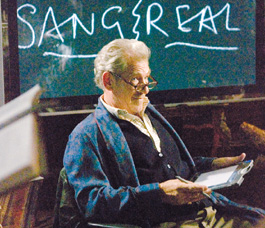home | metro silicon valley index | movies | current reviews | humor

Only the Shadow Knows: Ian McKellen understands the role of Bugs Bunny in Templar history, but he's not telling.
Veni, Vidi, Da Vinci
We dare to tell you what the mainstream media is afraid to reveal about the true meaning of 'The Da Vinci Code'
By Richard von Busack
MINUTES 1-33: Most of the first half-hour of The Da Vinci Code is plagiarized from my unpublished novel Double Crosses: The Chalice in the Palace. I would underscore the passages about the autographed portrait of Jesus ("Best Wishes, J.C."), last seen in Warner Bros.' famed animation lab, Termite Terrace, circa 1940. The portrait was authenticated in animator Chuck Jones' memoirs. In the now-missing portrait, J.C. is making a familiar two-fingered sign of blessing. The sign is an ancient symbol meaning "Where there's one, there's two."
Heading the list of suspects in the theft is the Kiwanis Club. The acronym of this centuries-old organization is Knights in Waiting for the Anointed Nazarene's Image, the final "s" not being an "s" but a serpent, not unlike the snakelike neckties worn by this elusive sect. "Carrows," a chain restaurant where the Kiwanis often meet, should be understood as the Old English spelling of "Carouse" meaning (italics, as always, mine) "to participate in drunken or debauched behavior." Such "carrowsing" is a hallmark of the Priory of Sion. "I was 'sion' [sighin'] when The Da Vinci Code reached the two-hour mark." So claimed one of my wittier students, who later vanished mysteriously, as if punished for terrible impiety by a limping albino assassin (Paul Bettany).
Minute 34: Bugs Bunny's essential place in this mythos has been suggested in Santa Cruz novelist Robert Anton Wilson's Illuminatus! trilogy. Wilson credits Adam Weishaupt, founder of the Illuminati, as coining the phrase "You Rascally Rabbit." What can be made of the scene in Joe Dante's The Looney Tunes Movie of Bugs X-raying the Mona Lisa for a "Da Vinci code" of his own? Much, I would say, much indeed, answering my own rhetorical question.
In that animated film, Bugs, Daffy and company sought a diamond—what more precious "diamond" could there be than a gem of forbidden fact? I mean, of course, the ancient legend of Jesus' identical twin sister, Jessina. ("Where there's one, there's two.")
Minute 35: Godfrey of Bouillon? I'm so glad you asked. This nobleman (1165-1204) made his fortune providing cubes of dehydrated broth to the Crusaders—a staple that kept the knights alive in the Holy Land. His patronage of the Kiwanis gave them immense power and riches. Their fortune was their downfall; it attracted the covetousness of Pope Winslow IV, who went medieval on their ass.
Minute 48: The first mention of Opus Dei. Note that director Ron Howard played a character called "Opie" ("He who belongs to the Opus") on The Andy Griffith Show. Later, he portrayed Richie Cunningham on Happy Days. Coincidentally, a "cunning ham" (Ian McKellen) is the only watchable thing about the movie.
Also interesting is the fact that this film stars Audrey Tautou, the star of Amélie. Her hit revivified La Basilique du Sacre Coeur in Montmarte, built by the conservative Catholics of the Sacred Heart. Some of the Sacre Coeur must have been on nodding terms with the Opus Dei when that secret group was organized in 1928.
In the scene between Inspector Bezu Fache (Jean Reno) and Robert Langdon (Tom Hanks), the former's name is of significance. The film's press notes tantalize us with the comment "Bezu is the location of a Knight's Templar fortress in the South of France, and Fache means 'a cross.'" Fache describes I.M. Pei's glass pyramid at the Louvre as "a scar on the face of Paris." Was it possible that in a deleted scene Langdon taunted Fache: "Yes, and Sacre Coeur is a wen upon her brow!" Sure, why not?
Minute 68: In the light of this "sub rosa" scene, Groucho Marx's signature song, "Show Me a Rose," takes on an eschatological meaning: "Show me a rose and I'll show you a girl named Sandy/ Show me a rose or leave me alone." The "girl named Sandy"? Who else is she but "she who is covered by the sands of time": Jessina of Nazareth, whose sacred tomb was hidden by the Kiwanis! (Exclamation point mine. I don't have to ration them; they don't cost anything.) Clearly Groucho "bet his life" by issuing this challenge to the Kiwanis, even in the frame of a nonsense tune.
Minute 140: Also consider Lou Reed's line "I feel like Jesus' son" in the song "Heroin," essential to the mystery of Jessina's last resting place. Kiwanis-sympathizing record officials forced Reed to change the lyric to "Jesus' son" from "Jesus' twin sister" (!) "Heroin" is a homophone with "Harold Gwynn," a humble 1920s denizen of the border land "where St. Joseph's City meets Sainte Clare." ("Sainte Clare, one of the oldest names in France!" exclaims Hanks' Langdon.) And that verse predicting Santa Clara and "St. Joseph's City"—our modern San Jose(!) (!!) is a prophecy from the Gospel of St. Manny, rendered into apocrypha at the Council of Nicea.
Mr. Gwynn's apricot orchard on Park Avenue was purchased (drum roll, please) by the rose-symbol-using Rosicrucian Order for their temple and museum. (And said museum just "happens" to be hosting an exhibit this summer called "Leonardo Da Vinci: Artist, Scientist, Mystic"—conspiracy or coincidence?) Seekers! She waits for us in San Jose, under the "Big W" of palm trees near the reflecting pool with the obelisk. We'll meet in the parking lot at OSH at noon today to get some picks and shovels.
Send a letter to the editor about this story.
|
|
|
|
|
|